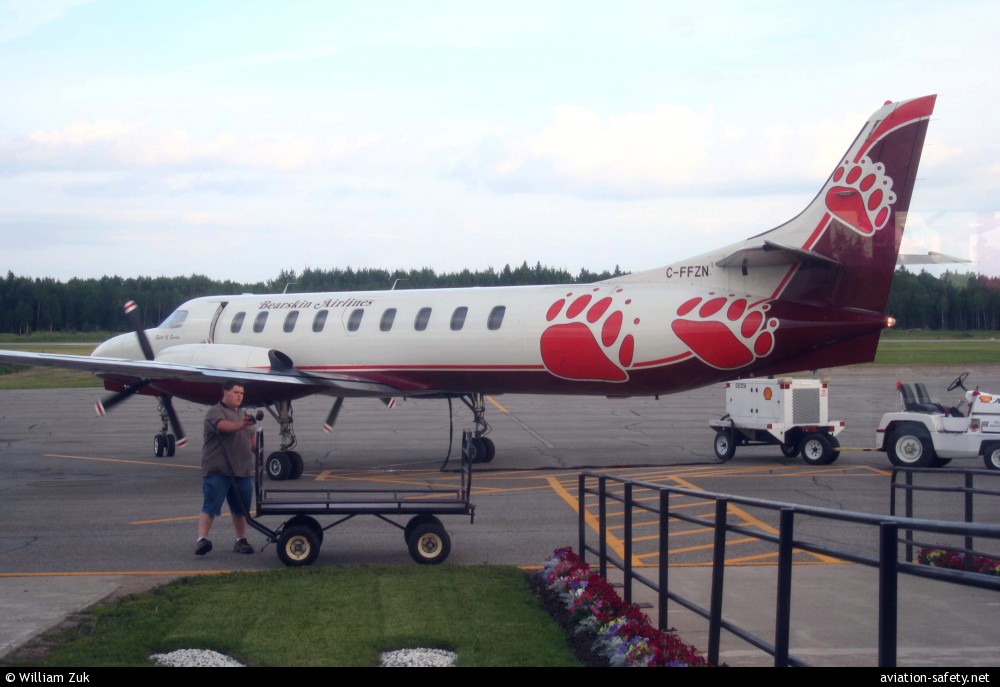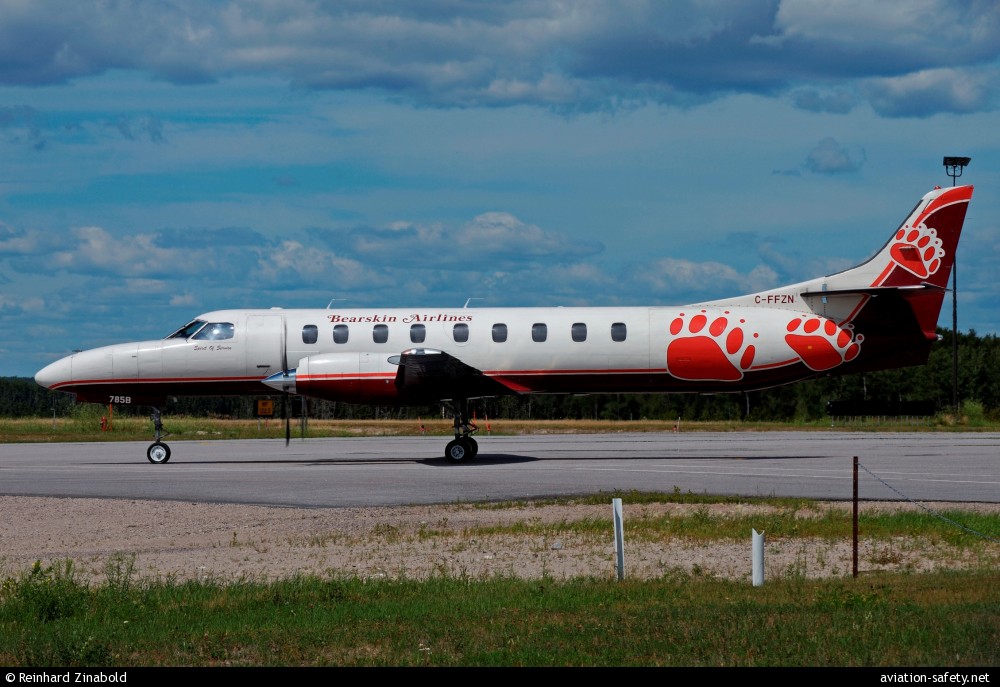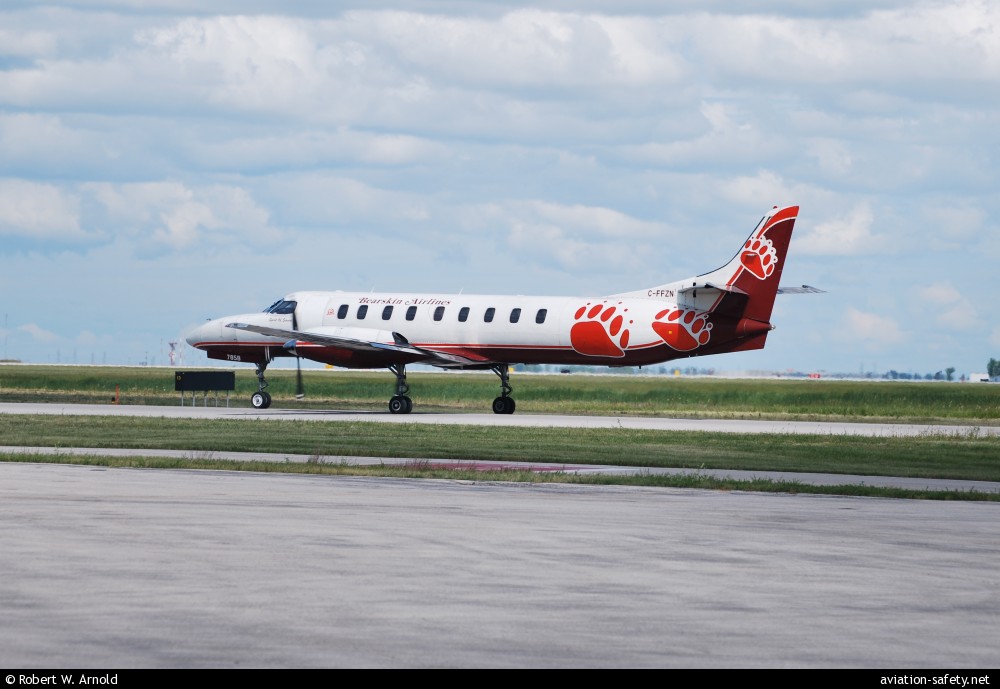
| Date: | Sunday 10 November 2013 |
| Time: | 18:29 |
| Type: |  Fairchild SA227-AC Metro III |
| Owner/operator: | Bearskin Airlines |
| Registration: | C-FFZN |
| MSN: | AC-785B |
| Year of manufacture: | 1991 |
| Total airframe hrs: | 35474 hours |
| Engine model: | Garrett TPE331-11U-612G |
| Fatalities: | Fatalities: 5 / Occupants: 7 |
| Aircraft damage: | Destroyed, written off |
| Category: | Accident |
| Location: | ca 0,8 km S of Red Lake Airport, ON (YRL) -
 Canada Canada
|
| Phase: | Approach |
| Nature: | Passenger - Scheduled |
| Departure airport: | Sioux Lookout Airport, ON (YXL/CYXL) |
| Red Lake Airport, ON (YRL/CYRL) | |
| Investigating agency: | TSB |
| Confidence Rating: |
Bearskin Airlines Flight JV311 crashed while on approach to runway 26 at Red Lake Airport, Ontario, Canada. Both pilots and three of the five passengers were killed in the accident.
Flight 311 was a scheduled flight between Thunder Bay, Ontario, and Winnipeg, Manitoba, with stops in Sioux Lookout, Ontario, and Red Lake, Ontario. The flight from Thunder Bay and the subsequent departure from Sioux Lookout were uneventful.
At 18:16, Winnipeg ACC cleared Bearskin 311 to the Red Lake Airport for the VOR/DME runway 26 approach, and advised the pilots to contact Kenora Flight Service Station (FSS).
The descent checklist was carried out and, at 18:17, the crew advised Kenora FSS that they had been cleared by Winnipeg ACC for an approach to runway 26 at the Red Lake Airport. Because the crew were expecting to encounter visual conditions prior to landing, a full approach briefing was not carried out.
The landing checklist was completed and, at 18:27, the crew advised Kenora FSS that they were 5 nautical miles (nm) on final approach for runway 26 at the Red Lake Airport. At 18:28, at approximately 500 feet above ground level and approximately 1.4 nm from the runway, the crew noted an aircraft malfunction but did not immediately identify the nature of it. Maximum power was applied to one or both engines, and the landing gear was initially selected up and then re-selected down before it could fully retract. The crew declared an emergency with Kenora FSS and unsuccessfully attempted to initiate a climb. Shortly afterwards, the aircraft veered and rolled to the left, descended, and struck trees with its left wing. The aircraft continued through the trees and struck a series of hydro lines that ran parallel to Ontario Highway 125, before coming to rest in a wooded area adjacent to the highway.
A post-crash fire erupted.
Findings as to causes and contributing factors:
1. A first-stage turbine wheel blade in the left engine failed due to a combination of metallurgical issues and stator vane burn-through.
2. As a result of the blade failure, the left engine continued to operate but experienced a near-total loss of power at approximately 500 feet above ground level, on final approach to Runway 26 at the Red Lake Airport.
3. The crew were unable to identify the nature of the engine malfunction, which prevented them from taking timely and appropriate action to control the aircraft.
4. The nature of the engine malfunction resulted in the left propeller being at a very low blade angle, which, together with the landing configuration of the aircraft, resulted in the aircraft being in an increasingly high drag and asymmetric state. When the aircrafts speed reduced below minimum control speed (VMC), the crew lost control at an altitude from which a recovery was not possible.
Findings as to risk:
1. If pilots believe that the negative torque sensing (NTS) system in the SA227 aircraft will activate in the event of any power loss or that NTS activation alone can provide adequate anti-drag protection in the event of an engine power loss, there is a risk that flight crews operating these aircraft types may not initiate the Engine Failures In Flight checklist in a timely manner.
2. If there is no requirement for a boroscope inspection of the TPE331-11U-612Gs internal engine components in conjunction with the 450-hour fuel nozzle inspection, there is an increased risk that premature internal engine damage will not be detected.
3. If there are discrepancies between the fuel nozzle testing procedures described in the TPE331-11U-612G maintenance manual and the corresponding fuel nozzle overhaul manual, there is a risk that unserviceable fuel nozzles may be evaluated as serviceable and re-installed on aircraft.
METAR:
00:00 UTC / 18:00 local time:
CYRL 110000Z 30014G22KT 10SM -SN DRSN OVC018 M10/M13 A3008 RMK SC8 SLP212
00:44 UTC / 18:44 local time:
CYRL 110044Z 32010KT 8SM -SN DRSN SCT020 RMK SC3 ACCIDENT CHECK VIA CYPL
Wind 320 degrees at 10 knots; Visibility: 8 miles; Light snow, low drifting snow; Scattered clouds at 2000 feet AGL.01:00 UTC / 19:00 local time:
CYRL 110100Z 32010KT 8SM -SN DRSN SCT020 M11/M13 A3011 RMK SC3 VIA CYPL SLP224
Accident investigation:
 |
|
Sources:
CADORS 2013O3414
History of this aircraft
Other occurrences involving this aircraft
| 23 February 1994 | C-FFZN | Bearskin Lake Air Service | 0 | North Bay Airport, Ontario |  |
sub |
| 22 November 1999 | C-FFZN | Bearskin Lake Air Services | Dryden, Ontario |  |
||
| Runway excursion | ||||||
Location
Images:

photo (c) William Zuk; 23 July 2007; (publicdomain)

photo (c) Reinhard Zinabold; Sioux Lookout Airport, ON (YXL/CYXL); 26 July 2011

photo (c) Robert W. Arnold; Winnipeg International Airport, MB (YWG/CYWG); 10 August 2013
Revision history:
| Date/time | Contributor | Updates |
|---|
The Aviation Safety Network is an exclusive service provided by:


 ©2024 Flight Safety Foundation
©2024 Flight Safety Foundation